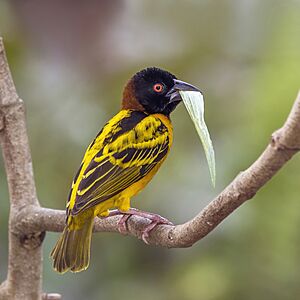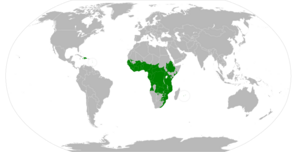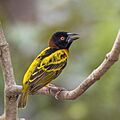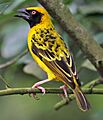Village weaver facts for kids
Quick facts for kids Village weaver |
|
|---|---|
 |
|
| Male P. c. cucullatus | |
 |
|
| Female P. c. cucullatus, Gambia | |
| Conservation status | |
| Scientific classification | |
| Genus: |
Ploceus
|
| Species: |
cucullatus
|
| Subspecies | |
|
See text |
|
 |
|
| Synonyms | |
|
|
The village weaver (Ploceus cucullatus) is a common and noisy bird found across much of sub-Saharan Africa. It's also known as the spotted-backed weaver or black-headed weaver. These birds are famous for their amazing nest-building skills!
Village weavers live in many different places, like woodlands and even towns and villages. They often form large, loud groups in places where people live, like hotel grounds. These weavers build big, strong nests from grass and leaf strips. Their nests hang from tree branches and have an entrance that points downwards. Female weavers usually lay two or three eggs. Many nests can hang from one tree because village weavers like to breed in colonies.
These birds mainly eat seeds and grains. Sometimes, they can be a problem for farmers because they eat crops. However, they also eat insects, especially when they are feeding their young. This helps to balance out any damage they might cause to farms. The village weaver's calls sound like harsh buzzing and chattering noises.
Contents
About the Village Weaver
The village weaver is a well-known bird species. Its scientific name, Ploceus cucullatus, means "hooded weaver" in Latin. This name describes the dark head of the male bird.
Different Types of Village Weavers
Scientists have identified eight different types, or subspecies, of the village weaver. These subspecies are slightly different depending on where they live.
- P. c. cucullatus – Found from Mauritania to Cameroon, and on Bioko island. It has also been introduced to Hispaniola.
- P. c. abyssinicus – Lives in northern Sudan, Eritrea, and Ethiopia.
- P. c. bohndorffi – Found in southern Sudan, northern Democratic Republic of Congo, Uganda, western Kenya, and north-western Tanzania.
- P. c. collaris (mottled weaver) – Lives in Gabon, western Democratic Republic of Congo, and Angola.
- P. c. graueri – Found in eastern Democratic Republic of Congo, Rwanda, and western Tanzania.
- P. c. frobenii – Lives in southern and south-eastern Democratic Republic of Congo.
- P. c. nigriceps (Layard's weaver) – Found from southern Somalia and eastern Kenya to southern Angola, western Zimbabwe, eastern Zambia, and central Mozambique. It also lives on São Tomé.
- P. c. spilonotus (spotted-backed weaver) – Lives in south-eastern Botswana, eastern South Africa, and southern Mozambique. It has also been introduced to Mauritius, Réunion, and Venezuela.
What Village Weavers Look Like
The village weaver is a sturdy bird, about 15–17 centimeters (6–7 inches) long. It has a strong, cone-shaped bill and dark reddish eyes.
Male and Female Birds
Male village weavers look different depending on the season and where they live.
- When breeding, males in the northern areas have a black head with chestnut (reddish-brown) edges.
- In southern areas, breeding males have less black and chestnut. They might only have a black face and throat, with a yellow head.
- All breeding males have a black bill, black and yellow upper parts and wings, and yellow underparts.
When not breeding, the male's head turns yellow with an olive-green top. Their upper parts become grey, and their underparts are whitish. Their wings stay yellow and black.
Female village weavers have streaky olive-green upper parts, yellow and black wings, and pale yellow underparts. Young birds look similar to the females but are browner on their backs.
Where Village Weavers Live
The village weaver is one of the most common weaver birds. It is found all over sub-Saharan Africa, but not in the very dry areas. It has also been brought to islands in the Indian Ocean and the Caribbean. Here, they have adapted well to the similar climates.
Village Weaver Behavior
Village weavers often gather in large groups to find food and to sleep. Sometimes, they even move along the same paths regularly. They look for food on the ground, but also search in plants and trees.
Nest Building and Colonies
Village weavers are very busy during their breeding season. They build their nests in groups called colonies. Birds are constantly flying in and out, making a lot of noise. A single tree can hold anywhere from eight to one hundred nests, and some colonies can have as many as 150 nests!
A village weaver's nest is about 14–17 cm (5.5–6.7 inches) long and 11–13 cm (4.3–5.1 inches) high. The entrance often has a tube that is 4–8 cm (1.6–3.1 inches) long. The male weaver builds the main part of the nest. He uses long strips of leaves that he tears from palm trees or large grasses.
The nest is shaped like an oval or a kidney and has a roof. Inside, there's a main nesting room separated by a small wall from an entrance area. The male works very carefully, weaving the leaf strips together. He starts by making a ring around two hanging branches, then builds the main nesting chamber. After that, he adds the roof of the entrance area and the entrance tube. The female weaver also helps by collecting soft materials like short grass strips and feathers to line the inside of the nesting cup.
Gallery














